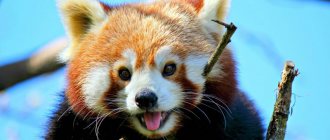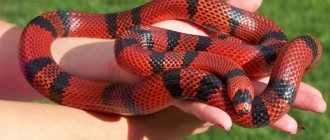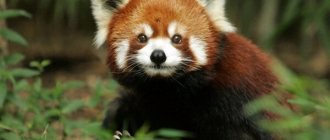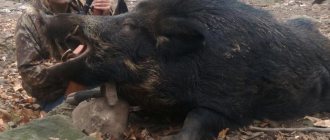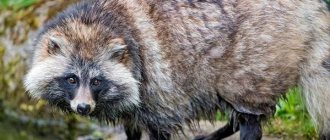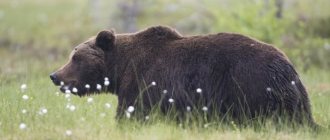The world became aware of the big and small panda only at the end of the nineteenth century, despite the fact that they are very ancient and rare animals. From the moment of discovery, the study of these interesting and unusual animals began. But after two centuries of constant research, much about these mammals still remains a mystery. Scientists cannot come to a common opinion about the class of these animals. This problem is further aggravated by the fact that these two types have many differences between them. Therefore, nowadays you can hear a lot of discussions on the topic: “Is a panda a bear or a raccoon?”
Description of the large “bamboo bear”
This type of animal is usually classified as a mammal, a carnivorous order, a raccoon family, and a panda subfamily. But not so long ago, the Australian researcher E. Tennius conducted a series of morphological, cardiological, ethological and biochemical analyses. Based on the results, the scientist found that out of sixteen characteristics, five of the giant panda are a raccoon, and the remaining twelve are characteristic only of it alone.
If we consider the appearance of this animal, then the giant panda is undoubtedly more similar to bears, because it is not without reason that it is also called “bamboo bear.” She has a massive body that is completely covered with thick fur. Its length varies from 1.1 to 1.9 meters, and its weight ranges from 75 to 140 kilograms. The thick and short legs of this animal end in massive paws with large claws.
If you look closely at the sole, you can see that on it and near each toe there are peculiar pads that serve the animal to hold smooth and slippery bamboo stems.
Unlike a bear, this animal has a tail, the length of which reaches 13 cm, and teeth with a different structure. On the panda's premolars you can see protrusions and tubercles that are not found in any other species of bear, and its head is massive and blunt-faced, with large erect ears.
The description of this species of panda says that it has a white color with characteristic black spots near its eyes, black legs and a tail of the same color. And although she looks like a bear, some features of her anatomy have forced scientists to doubt this. In their opinion, the panda is a representative of the raccoon family, and some even identified it as a special class of mammals.
Scientific classification
- Domain: eukaryotes
- Kingdom: Animals
- Subkingdom: eumetazoans
- No rank: bilaterally symmetrical
- No rank: deuterostomes
- Type: chordates
- Subphylum: vertebrates
- Infratype: gnathostomes
- Superclass: quadrupeds
- Class: mammals
- Subclass: animals
- Infraclass: placental
- Superorder: Laurasiotherium
- Order: carnivores
- Suborder: Caniformes
- Family: bears
- Genus: giant pandas
- Species: giant panda
What does the small species of these interesting animals look like?
This species, according to scientists, belongs to the raccoons, since it has the same tail with striped colors, a similar muzzle, as well as the shape of the skull and the structure of the teeth. Although its discoverers were inclined to believe that the red panda is actually a cat with a fiery red color. This animal also has two subspecies - Western and Chinese.
This animal, unlike its larger relatives, has a body whose length reaches a maximum of 67 cm, with a tail up to 47 cm and a weight not exceeding 6 kg. Therefore, if you answer the question: “Is a panda a bear or not?”, then we can safely say that the small species of these animals with a red color is more related to raccoons than to bears.
Spreading
Giant pandas live in the mountains in the heart of China. The regions of Sichuan and Tibet are considered their home. Their entire life is spent in forests where mainly bamboo grows; they are located at an altitude of 1500-4600 m above sea level. This area has fairly moderate climatic conditions and all seasons of the year are pronounced. In addition, these animals live in many centers and zoos, where they continue to be studied and researched. In captivity, their lifespan reaches 27 years, and in the wild it is even shorter.
The red panda lives in China, Nepal, Bhutan and Myanmar. She lives, like her large relative, in the mountains at an altitude of 4800 m. This small animal inhabits the forests of Assam, as well as the provinces of Sichuan and Yunnan. This animal lives in 86 other zoos around the world.
Despite the fact that the large and small species differ significantly from each other in appearance and scientists believe that one panda is a bear and the other is a raccoon, they lead the same lifestyle.
Who is the red panda?
Unfortunately, the animal is listed in the Red Book as an endangered species. According to various sources, there are 2,500-10,000 individuals left on the planet. This animal has few natural enemies; the main problem is deforestation where this species lives. No less dangerous are poachers who destroy animals for luxurious fur. The fire fox reproduces well in captivity, zoos around the world are trying to restore the population, but the situation remains precarious.
origin of name
The first official name of the red panda - Ailurus fulgens - was given by the Frenchman Frederic Cuvier. However, earlier this type of fauna was discovered by Thomas Hardwig and suggested calling the animal “ua”, as the red animal sounds like. The fiery fox began to be called panda from the Nepalese “punya”. The name firefox is not justified, the animal is not related to foxes, until recently its closest relative was a raccoon, but this information was denied. Many years ago, the dwarf and giant panda shared a common ancestor, both species are classified in the family Ailuridae.
Behavior
These animals mostly live alone. The only exceptions can be considered the mating season and the time of raising their cubs. Mature individuals live in an area of about five square meters, which is much smaller than that of bears. In order to indicate their presence, they can use marks with a specific odor.
The giant panda, unlike the small panda, is active at any time of the day or night. Its red relative is nocturnal, and during daylight hours it sleeps in the treetops, curled up in a ball and resting its head on its large striped tail.
Number of red pandas and captivity
The orange panda is listed in the Red Book. According to various sources, there are up to 10 thousand individuals left on the planet. However, the mini panda thrives in captivity. 350 animals are registered in 85 zoos around the world , which reproduce well in an artificial environment. But the population is recovering very slowly, the red fox gives birth only once a year, and the litter usually contains 2 puppies.
Is it possible to tame the Fire Fox?
Unfortunately, domestication of red pandas as pets is practiced in India and Nepal. Not only is this blasphemy towards an endangered species, but it is also very difficult to create favorable conditions for the life of an animal at home, because the life expectancy of such pets is sharply reduced. To preserve this species on the planet, it is necessary to abandon the idea of purchasing such a pet. It's better to admire these cute creatures in zoos.
Nutrition
Numerous and dense thickets of bamboo are food for both the giant and the red panda. Thirty species of this plant make up approximately 99 percent of their diet. They also willingly eat all kinds of berries, fruits, seeds and acorns. Sometimes they can even hunt small birds, reptiles and rodents.
In captivity, they are fed the same bamboo, as well as biscuits and insect larvae. The panda is one of the few animals that can eat food in any position of its body, even lying down.
Reproduction
Individuals of the two species reach sexual maturity closer to five years, and begin to mate only at seven. Females during their mating season, which ranges from two days to a week, make loud sounds and actively emit a specific odor.
After this, pregnancy occurs, which lasts for these animals for an average of five months. Usually one or two naked cubs are born with a body weight of no more than 200 grams and a length of 14 to 16 cm, just like brown bears. Although scientists have not yet come to a clear conclusion about whether a panda is a bear or not, the reproduction process of these two animals is similar.
Beautiful legend
The charming black and white bear cub has earned fame and love all over the world. There is an ancient legend in China that explains the panda's coloring.
According to this legend, once upon a time, a family of shepherds settled on the slopes of the mountains. Every day, the shepherds took a flock of sheep to the pasture, where a little panda came to play with them. But one day a leopard attacked the sheep.
The sheep ran away, but the little bear cub could not run fast and did not have time to hide. And he could not escape death. But the young shepherdess took a stick and drove the leopard away from the little bear cub, and she herself died from the claws of the terrible beast.
Having learned about this, the pandas began to cry and sprinkled themselves with ashes as a sign of mourning for the brave girl. Wiping away tears, they left black spots on their snow-white skin. Since then, the panda skin has been a mourning for the dead girl.
Offspring
At birth, their cubs, like all varieties of bears, are helpless and blind. The female raises her little puppies herself and treats them very carefully and with special care. For several days after their birth, she does not leave the hole for a minute, even to eat or drink. The mother puts her cubs to her breast fifteen times a day, and one feeding can last about half an hour.
A panda most often gives birth to twins, but after some time the female chooses the strongest baby from them and continues to take care of him, and the second one, accordingly, dies unattended. The lactation period for these animals lasts approximately 45 weeks, and the cubs remain with their mothers until they reach three years of age.
Interesting Facts
It turns out that for the first time, when scientists conducted research on a large species of these animals, they could not understand for a long time who the panda was and what kind of animal it was. A little later they came to the conclusion that she was a raccoon, but only of enormous size.
After some time, other experts refuted this opinion, since with the help of a genetic test it was possible to establish that this species of animal is more related to bears.
As for red pandas, many scientists generally recorded them as a marten-like species, which consists of the mustelidae family, as well as raccoons and skunks.
Although, according to most researchers, these two subspecies belong to different classes, they still have a certain similarity with each other. For example, both pandas have a sixth "pseudo-toe" located on their front paws. It is significantly larger than the other five. This part of the body is actually a carpal bone covered with skin. This structure helps animals better hold onto bamboo plants.
Panda habitat - in which country do they live?
Habitat of pandas
Pandas are distributed mainly in Asia, to the east of the Himalayan mountains.
At the same time, small pandas are much more common than big pandas. The animals are extremely rare; the population of giant pandas is limited to the provinces of China: Gansu, Sichuan and Shanxi, which are located in the center of the country. The habitat covers about 29.5 thousand km2, but only a small part can be considered the habitat of pandas. Interesting fact : panda is translated from Chinese as bear-cat.
Conservation status
Unfortunately, pandas are on the verge of complete extinction, so they are listed in the International Red Book. This happens for many reasons. A live red panda is not as interesting to people as its fur. Because of this, she was constantly hunted, especially in Nepal. But recently, the numbers of this species have begun to gradually recover.
Giant pandas are also protected by law, according to which the extermination of this animal will be punishable by death or life in prison.
Although this animal was discovered several centuries ago, and in 1912 even became the national treasure of the People's Republic of China (according to the legislation of this Republic), scientists still cannot come to a definite conclusion about whether the panda is a bear or a raccoon. Therefore, research on this animal continues to this day.
Economic significance for humans
Positive
Giant pandas have been constantly poached for their valuable fur. According to some beliefs, a rug made of skin will protect a person sleeping on it from attacks by night ghosts, and will also show the near future. In Japan, you can buy panda skin for a considerable price. Giant pandas are extremely popular; zoos make a lot of money by allowing people who want to see the strange animals on their premises.
Negative
Bamboo bears pose little threat to the economy due to the fact that they are extremely rare. Of course, keeping pandas in nature reserves reduces the number of territories that could be used for agriculture, but pandas are too rare a species that brings a lot of money to the state. Therefore, the benefits of animals are disproportionately greater than the negative consequences.


